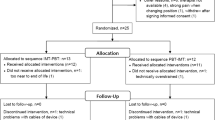Abstract
The purpose of this study is to determine whether neuromuscular electrical stimulation of the suprahyoid muscle is effective compared to that of the infrahyoid muscle in brain-injured patients with dysphagia. A total of 132 patients with stroke, traumatic brain injury, or brain tumor in 2 university hospitals were allocated to 2 groups: those who received electrical stimulation therapy (EST) on the suprahyoid muscles (SM group, n = 66) and those who received EST with one pair of electrodes on the suprahyoid muscle and the other pair on the infrahyoid muscle (SI group, n = 66). Patients received 11.2 ± 3.4 sessions of electrical stimulation in the SM group and 11.9 ± 3.4 sessions in the SI group. The functional dysphagia scale (FDS), swallow function score (SFS), supraglottic penetration, and subglottic aspiration were measured using videofluoroscopic swallowing study. FDS scores decreased from 42.0 ± 19.1 to 32.3 ± 17.8 in the SM group and from 44.8 ± 17.4 to 32.9 ± 18.8 in the SI group by per-protocol (PP) analysis, and those decreased from 41.2 ± 20.9 to 34.5 ± 20.3 in the SM group and from 44.3 ± 19.1 to 35.7 ± 20.5 in the SI group by intention-to-treat (ITT) analysis, after electrical stimulation (p < 0.001 for each). SFSs increased from 3.3 ± 1.8 to 4.2 ± 1.6 in the SM group and from 2.8 ± 1.8 to 4.0 ± 1.8 in the SI group by PP analysis, and those increased from 3.3 ± 1.6 to 3.9 ± 1.6 in the SM group and from 2.8 ± 1.9 to 3.6 ± 2.0 in the SI group by ITT analysis, after electrical stimulation (p < 0.001, respectively). However, changes in FDS scores, SFSs, penetration, and aspiration were comparable between the SM and the SI groups. The results suggest that both SM and SI therapies induced similar improvements in swallowing function in brain-injured patients.






Similar content being viewed by others
References
Martino R, Foley N, Bhogal S, Diamant N, Speechley M, Teasell R. Dysphagia after stroke: incidence, diagnosis, and pulmonary complications. Stroke. 2005;36:2756–63.
Leelamanit V, Limsakul C, Geater A. Synchronized electrical stimulation in treating pharyngeal dysphagia. Laryngoscope. 2002;112:2204–10.
Burnett TA, Mann EA, Cornell SA, Ludlow CL. Laryngeal elevation achieved by neuromuscular stimulation at rest. J Appl Physiol. 2003;94:128–34.
Kim DY, Koh ES, Kang BS, Han TR, Lee SU. Effects of electrical stimulation for dysphagia caused by stroke. J Korean Acad Rehabil Med. 2008;32:9–14.
Humbert IA, Poletto CJ, Saxon KG, Kearney PR, Crujido L, Wright-Harp W, Payne J, Jeffries N, Sonies BC, Ludlow CL. The effect of surface electrical stimulation on hyolaryngeal movement in normal individuals at rest and during swallowing. J Appl Physiol. 2006;101:1657–63.
Ludlow CL, Humbert I, Saxon K, Poletto C, Sonies B, Crujido L. Effects of surface electrical stimulation both at rest and during swallowing in chronic pharyngeal Dysphagia. Dysphagia. 2007;22:1–10.
Kim SJ, Han TR. Effect of surface electrical stimulation of suprahyoid muscles on hyolaryngeal movement. Neuromodulation. 2009;12:134–40.
Beom J, Kim SJ, Han TR. Electrical stimulation of the suprahyoid muscles in brain-injured patients with dysphagia: a pilot study. Ann Rehabil Med. 2011;35:322–7.
Wijting Y, Freed ML. VitalStim therapy training manual. Hixson: Chattanooga Group; 2003. p. 103–9.
Carnaby-Mann GD, Crary MA. Adjunctive neuromuscular electrical stimulation for treatment-refractory dysphagia. Ann Otol Rhinol Laryngol. 2008;117:279–87.
Nam HS, Beom J, Oh BM, Han TR. Kinematic effects of hyolaryngeal electrical stimulation therapy on hyoid excursion and laryngeal elevation. Dysphagia. 2013;28:548–56.
Paik NJ, Kim IS, Kim JH, Oh BM, Han TR. Clinical validity of the functional dysphagia scale based on videofluoroscopic swallowing study. J Korean Acad Rehab Med. 2005;29:43–9.
Freed ML, Freed L, Chatburn RL, Christian M. Electrical stimulation for swallowing disorders caused by stroke. Respir Care. 2001;46:466–74.
Lim KB, Lee HJ, Lim SS, Choi YI. Neuromuscular electrical and thermal-tactile stimulation for dysphagia caused by stroke: a randomized controlled trial. J Rehabil Med. 2009;41:174–8.
Gow D, Hobson AR, Furlong P, Hamdy S. Characterising the central mechanisms of sensory modulation in human swallowing motor cortex. Clin Neurophysiol. 2004;115:2382–90.
Blumenfeld L, Hahn Y, Lepage A, Leonard R, Belafsky PC. Transcutaneous electrical stimulation versus traditional dysphagia therapy: a nonconcurrent cohort study. Otolaryngol Head Neck Surg. 2006;135:754–7.
Carnaby-Mann GD, Crary MA. Examining the evidence on neuromuscular electrical stimulation for swallowing: a meta-analysis. Arch Otolaryngol Head Neck Surg. 2007;133(6):564–71.
Park JW, Oh JC, Lee HJ, Park SJ, Yoon TS, Kwon BS. Effortful swallowing training coupled with electrical stimulation leads to an increase in hyoid elevation during swallowing. Dysphagia. 2009;24:296–301.
Park JW, Kim Y, Oh JC, Lee HJ. Effortful swallowing training combined with electrical stimulation in post-stroke dysphagia: a randomized controlled study. Dysphagia. 2012;27:521–7.
Acknowledgments
This study was supported by Cyber-medic Corp., Iksan, Republic of Korea.
Conflict of interest
The authors declare that they have no conflict of interest.
Author information
Authors and Affiliations
Corresponding author
Electronic supplementary material
Below is the link to the electronic supplementary material.
Rights and permissions
About this article
Cite this article
Beom, J., Oh, BM., Choi, K.H. et al. Effect of Electrical Stimulation of the Suprahyoid Muscles in Brain-Injured Patients with Dysphagia. Dysphagia 30, 423–429 (2015). https://doi.org/10.1007/s00455-015-9617-2
Received:
Accepted:
Published:
Issue Date:
DOI: https://doi.org/10.1007/s00455-015-9617-2



